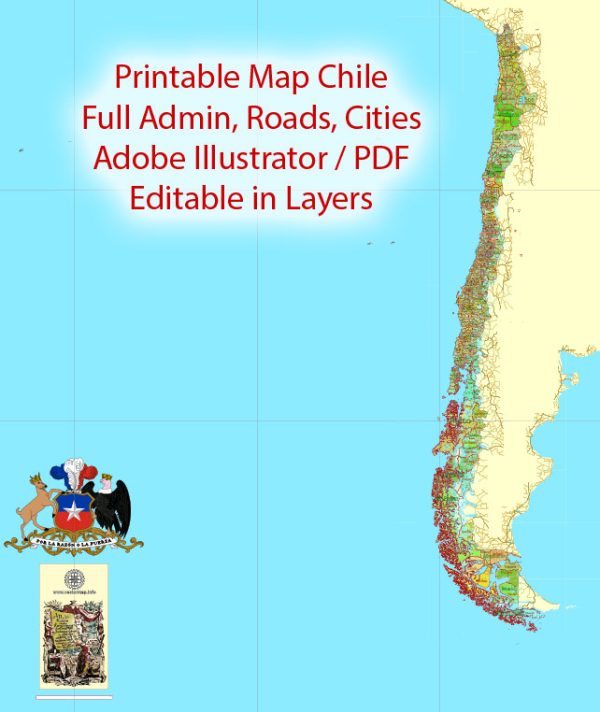Chile’s political and economic history is marked by various phases, including periods of authoritarian rule, economic reforms, and social transformations.
Vectormap.Net provide you with the most accurate and up-to-date vector maps in Adobe Illustrator, PDF and other formats, designed for editing and printing. Please read the vector map descriptions carefully.
Here’s a detailed overview:
Political History:
- Colonial Era (16th-19th centuries):
- Chile was initially inhabited by indigenous peoples such as the Mapuche. Spanish explorer Pedro de Valdivia founded Santiago in 1541, and Chile became part of the Spanish Empire.
- It remained a Spanish colony until the early 19th century, experiencing conflicts with indigenous groups and facing economic challenges.
- Independence (1810-1821):
- Inspired by independence movements across Latin America, Chilean patriots declared independence from Spain in 1810.
- After a period of internal strife and external conflicts, Chile officially gained independence in 1821.
- Consolidation and Stability (1821-1891):
- Chile experienced periods of political instability, including the War of the Pacific (1879-1884), where it gained territory from Bolivia and Peru.
- The 1833 Constitution provided a stable political framework, and during this period, Chile developed economically through the export of minerals, especially nitrate and copper.
- Parliamentary Era and Party System (1891-1925):
- The 1891 Chilean Civil War marked the transition from a presidential to a parliamentary system.
- Political parties, including the Conservative and Liberal Parties, played a significant role in shaping Chile’s political landscape.
- Authoritarian Rule (1973-1990):
- The military coup in 1973 led by General Augusto Pinochet ousted the elected government of Salvador Allende.
- Pinochet’s regime, characterized by human rights abuses and economic liberalization, lasted until 1990.
- Return to Democracy (1990-present):
- In 1990, Chile returned to democratic governance with the election of President Patricio Aylwin.
- Subsequent governments, from various political coalitions, have focused on consolidating democracy and addressing socio-economic issues.
Economic History:
- Early Economic Development (19th century):
- The 19th-century economy was dominated by agriculture, mining, and trade, with exports of wheat and minerals driving economic growth.
- Nitrate and Copper Boom (Late 19th-early 20th centuries):
- The nitrate and copper industries fueled economic prosperity, attracting foreign investment and shaping Chile’s economic structure.
- Economic Reforms (1960s-1970s):
- Chile underwent significant economic reforms in the 1960s and 1970s, including land redistribution and nationalization of certain industries under President Allende.
- Economic Liberalization (1970s-1990s):
- Pinochet’s regime implemented neoliberal economic policies, emphasizing free-market principles, privatization, and trade liberalization.
- Post-Dictatorship Economic Policies (1990-present):
- Subsequent democratic governments continued market-oriented reforms, promoting economic stability, trade openness, and attracting foreign investment.
- Social and Economic Inequality:
- Despite economic growth, Chile faced challenges related to social inequality, particularly in education, healthcare, and income distribution, leading to widespread protests in recent years.
- Diversification and Innovation (21st century):
- Chile has focused on diversifying its economy, investing in innovation, and expanding its role in the global market.
Chile’s history reflects a complex interplay of political events and economic shifts, shaping the country into a significant player in the Latin American region.


 Author: Kirill Shrayber, Ph.D.
Author: Kirill Shrayber, Ph.D.